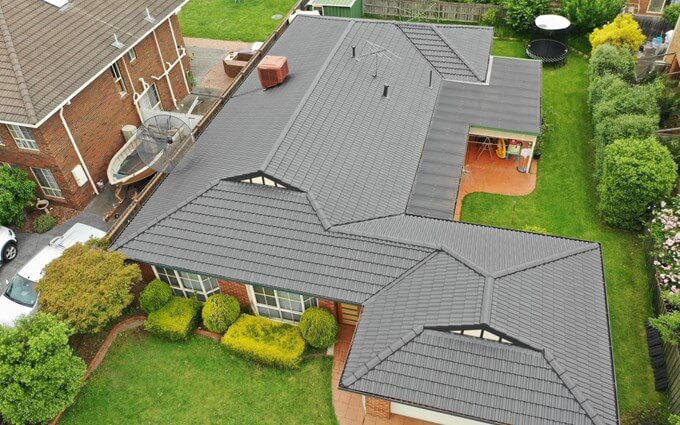It’s good to inspect your roof at least twice a year and after any major storm.
Why twice a year? Because there are two seasons when your property is most vulnerable to damage: spring and fall. The winter weather can bring high winds, rain or hail storms that can loosen roofing material or damage them outright. Summer storms are less common, but they still can cause damage, especially when accompanied by strong winds.
If you’re concerned about the costs of hiring a contractor for a full inspection, consider what might happen if you were to overlook damage and wind up with water in your attic or walls from a leaky roof. You’d probably spend far more repairing the interior damage than you would have on an inspection.
If your roof’s age is more than 20 years, it may have several damaged areas or show signs of significant wear. Professional roofers recommend replacing roofs before they reach the end of their useful life to avoid damage to the underlying structure.
When inspecting your roof, look for missing or broken roofing material, loose seams, and other damage.

Things to keep in mind during a roof inspection
Having your roof inspected annually is important to the maintenance of your home. A roof inspection can help you find potential problems and make sure that everything is operating as it should be. When having an inspection, there are a few things that you want to be on the lookout for to ensure that your roofing system will last for years.
- Granules in the Gutter
Tiles that have been on the roof for some time may begin to lose their granules. If this happens, it’s important to have them replaced before they cause significant damage. If you notice several granules in the gutters, then it’s time to call a professional roofer.
- Missing or damaged roofing material
If you notice any missing or damaged roofing material, then it’s time to replace them immediately. It makes the roof vulnerable to water damage and can lead to mould and mildew if not replaced quickly. Additionally, if you notice missing roofing material, especially after a storm, your entire roof could be compromised and may need replacing entirely.
- Inspect your flashing
Flashing is an important part of your roof that protects it from water damage. Anytime you’re inspecting the condition of your roof, make sure to check the flashing as well. You’ll want to make sure it’s not loose or damaged in any way before moving on to other projects.
- Take photos
Ensure you take detailed photos of the entire roof (and attic) before and after the job. If a roof tile blows off during a storm, you’ll have proof that it fell off. You’ll also need this documentation if you decide to sell your house in the future and want to prove that everything was done correctly at all times.
- Look for obvious problems
Look up at the rafters and inspect the underside of the roof tiles where they meet the gable ends. Check under your gutters and downspouts, which run along the edges of your roof and house. If something looks wrong, it probably is; if it doesn’t, it probably isn’t.
- Look for signs of leaks
If you see rips or tears in roofing material or around chimneys or other openings in your roof, you may have a problem with water seeping in from one of the spots.
The DON’Ts of Roof Inspection
But before you kick off the inspection, here are some DON’Ts to avoid:
- Don’t do the inspection yourself
It’s tempting to save money and just check out the roof yourself. But this can be more dangerous than you think, especially if you’re not trained in climbing to high places. Plus, you won’t be able to spot problems as well as a professional could. So leave it to a professional roof restoration expert in Cranbourne who knows what they’re doing!
- Don’t climb on the roof without protection.
A few simple precautions can make all the difference when it comes to protecting yourself against falling off your roof. When climbing on your roof, you should always wear climbing gear, such as a hard hat or a harness, and have a basic understanding of how roofs work before attempting repairs that could cause damage.
- Don’t skip safety inspections of gutters and downspouts; they can be flimsy and unsafe.
These components can be neglected year after year without causing problems, but they can also suffer serious damage during storms or other weather events, especially if they don’t drain properly or are old and rusted out. Call an expert if you see any cracks or leaks in these areas during an inspection.
- Don’t inspect your roof during bad weather.
Walking around on a steep, slippery roof during bad weather is dangerous. Inspecting your roof in the rain, hailstorm or high winds can also lead to inaccurate results due to water accumulation or other factors relating to moisture and precipitation. Wait until it’s sunny and dry outside before inspecting your roof.
- Don’t walk on your roof if you don’t have to.
It can be a challenge for inexperienced homeowners to safely navigate their roofs, especially if the slope is steep or uneven. It’s best to avoid walking around on your roof at all if possible because this increases the risk of accidentally damaging it. If you must walk on your roof, be sure that you take proper safety precautions by wearing non-slip shoes and using safety gear such as harnesses and ropes.
How to perform a roof inspection?
Performing a roof inspection doesn’t require special skills or technical knowledge. You can do it yourself! The following steps will show you how to perform a roof inspection.
- You may want to use binoculars for an overall view of your roof. This technique is also useful for inspecting the roof from the ground. A good pair of binoculars will allow you to see details such as missing roofing material and damaged areas that may be difficult for the naked eye to see.
- A good place to start is by inspecting your roof from a ladder or other high point on the ground. Do this before you climb onto the roof itself. This way, you can spot any obvious damage, such as missing roofing material or damaged flashing.
- Look at all sides of your home and from both ends of the house. Look for cracked or missing siding and loose gutters that could cause rainwater to back up into your attic or behind your walls.
- Check your garage and any other buildings on your property for water stains. They will appear as dark grey or black spots where water has leaked through a roof, wall, or floor.
- If you have vinyl siding, check it thoroughly for signs of damage, such as cracks or holes that could allow water to seep in behind the siding and into the framing of your house.
Conclusion
There’s no set schedule for inspecting your roof. If you live in a particularly warm or wet climate, you might want to inspect it more frequently. That said, you should perform at least one thorough inspection every year. That way, if something does go wrong and you notice it early enough, there’s a good chance that you’ll be able to get it repaired before it becomes a major problem.











